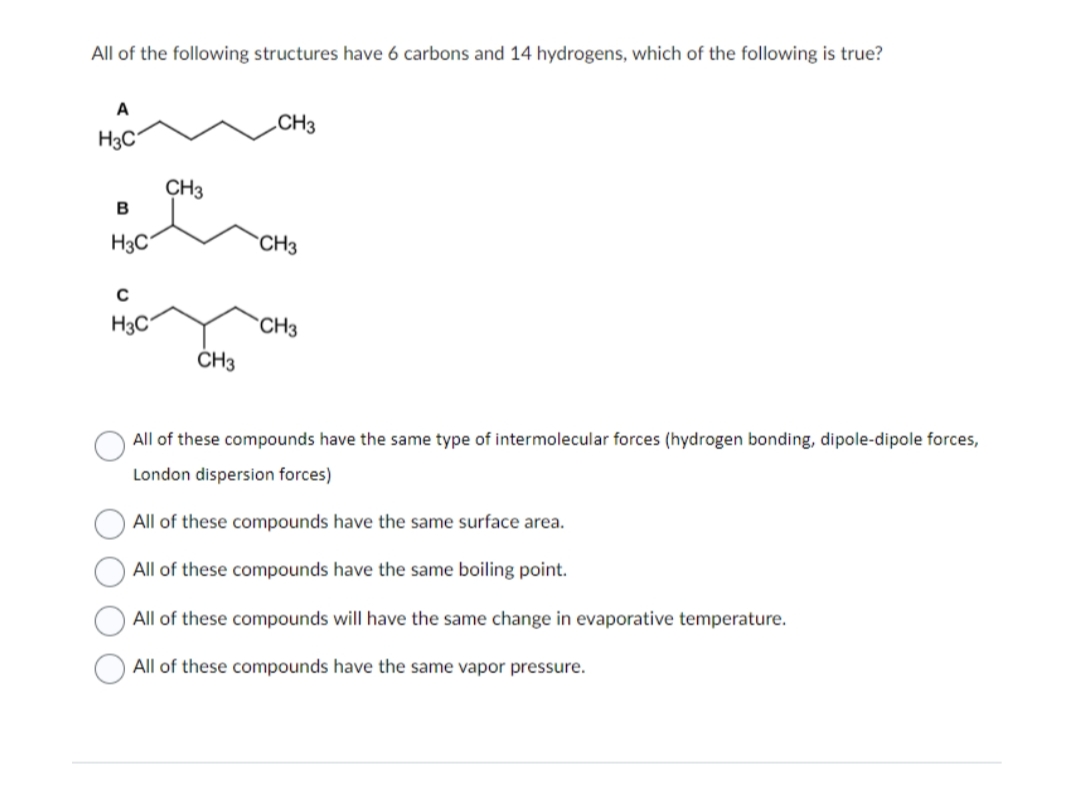All of the following structures have 6 carbons and 14 hydrogens, which of the following is true? A H3C B H3C1 C H3C CH3 CH3 CH3 CH3 CH3 All of these compounds have the same type of intermolecular forces (hydrogen bonding, dipole-dipole forces, London dispersion forces) All of these compounds have the same surface area. All of these compounds have the same boiling point. All of these compounds will have the same change in evaporative temperature. All of these compounds have the same vapor pressure.
All of the following structures have 6 carbons and 14 hydrogens, which of the following is true? A H3C B H3C1 C H3C CH3 CH3 CH3 CH3 CH3 All of these compounds have the same type of intermolecular forces (hydrogen bonding, dipole-dipole forces, London dispersion forces) All of these compounds have the same surface area. All of these compounds have the same boiling point. All of these compounds will have the same change in evaporative temperature. All of these compounds have the same vapor pressure.
Chemistry: Principles and Practice
3rd Edition
ISBN:9780534420123
Author:Daniel L. Reger, Scott R. Goode, David W. Ball, Edward Mercer
Publisher:Daniel L. Reger, Scott R. Goode, David W. Ball, Edward Mercer
Chapter11: Liquids And Solids
Section: Chapter Questions
Problem 11.103QE
Related questions
Question

Transcribed Image Text:All of the following structures have 6 carbons and 14 hydrogens, which of the following is true?
A
H3C
B
H3C
C
H3C1
CH3
CH3
CH3
CH3
CH3
All of these compounds have the same type of intermolecular forces (hydrogen bonding, dipole-dipole forces,
London dispersion forces)
All of these compounds have the same surface area.
All of these compounds have the same boiling point.
All of these compounds will have the same change in evaporative temperature.
All of these compounds have the same vapor pressure.
Expert Solution
This question has been solved!
Explore an expertly crafted, step-by-step solution for a thorough understanding of key concepts.
This is a popular solution!
Trending now
This is a popular solution!
Step by step
Solved in 3 steps

Knowledge Booster
Learn more about
Need a deep-dive on the concept behind this application? Look no further. Learn more about this topic, chemistry and related others by exploring similar questions and additional content below.Recommended textbooks for you

Chemistry: Principles and Practice
Chemistry
ISBN:
9780534420123
Author:
Daniel L. Reger, Scott R. Goode, David W. Ball, Edward Mercer
Publisher:
Cengage Learning



Chemistry: Principles and Practice
Chemistry
ISBN:
9780534420123
Author:
Daniel L. Reger, Scott R. Goode, David W. Ball, Edward Mercer
Publisher:
Cengage Learning



Chemistry: Principles and Reactions
Chemistry
ISBN:
9781305079373
Author:
William L. Masterton, Cecile N. Hurley
Publisher:
Cengage Learning

Chemistry: An Atoms First Approach
Chemistry
ISBN:
9781305079243
Author:
Steven S. Zumdahl, Susan A. Zumdahl
Publisher:
Cengage Learning

Chemistry by OpenStax (2015-05-04)
Chemistry
ISBN:
9781938168390
Author:
Klaus Theopold, Richard H Langley, Paul Flowers, William R. Robinson, Mark Blaser
Publisher:
OpenStax